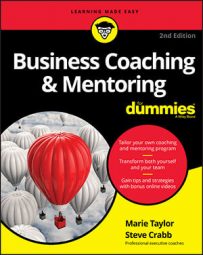- I should have grown up by now.
- I should work harder.
- I should have a bigger bonus and a better car.
- I should see my friends more.
- I should be happier.
- I should grow this business.
When the list is complete, get your client to take every one of the “shoulds” and consign them to a new library. You can help your clients do this activity by taking all the should statements and, for each one, asking the following questions:
- What’s stopping you from having this now?
- Is it something you want in your life now?
When you come to a title that is something your client wants but doesn’t have yet, ask, “What’s getting in the way?” or “What do you believe about getting this?” Invariably a limiting belief emerges. A limiting belief is something you think you can’t have or can’t achieve, a constraint or limitation that stops you from even questioning whether you can have it or achieve it.
Limiting beliefs aren’t always about getting more or achieving more. They can be about having, achieving, or doing less, too. Sometimes clients have a clear view about limitation such as “I’m not confident enough” or “I don’t have time.” Often clients don’t know what limits them. You may need to help your client surface the limiting belief and challenge it.
Removing limiting beliefs before implementing change processes is crucial; otherwise, the client tends to get in her own way.
Why look at limiting beliefs in mentoring?
If you think about what you’re doing in mentoring, you’re imparting your wisdom to help clients examine what they might do the same, adapt, or discard. Sometimes their response can be a head-level response such as, “Yes, I understand how you did that and why you handled the issue that way.” Then comes the “but.” It sounds like this: “But I’m not sure I could do a similar thing in this context. I can see that it would work. I just don’t think I could deliver it.”Alternatively, you’ll hear in the client’s language that she keeps talking in the abstract or in the third person, as though this situation she is looking to resolve belongs to you or someone else: “I can see how you would do that… .”
As a mentor, you need to challenge this issue head-on because you want to help the client take action. A challenge might be, “Now that you can see how I did that, walk me through how you’ll apply this learning in your particular context.”
This point is when the limiting beliefs may emerge. The beliefs are born out of fear or hidden thresholds, often unconscious limitations that are there to keep you safe and in a zone of comfort. This fear normally is of not succeeding; not being good enough, confident enough, capable enough; of looking stupid, looking arrogant, looking some way that the client doesn’t want to be perceived. We all do this. Your job is to help the client remember that we’re all making it up. Such thoughts are just beliefs — they’re not real. Thresholds are not real — they’re just thoughts.
Be kind when you help a client become aware of this concept because she hasn’t realized yet that she has built some of this wall of self-limitation herself. She may not have put the foundations in intentionally or consciously — she may even have inherited that from someone else’s story — but she has nonetheless created them. This awareness gives a client a lot of power because she also has the ability to overcome and change any limitations.
Your client may have formed a limiting belief so long ago that she can’t recall where and how she became fearful. She, and you, as the mentor, don’t need to understand it. You just need to question it, and then get rid of it so your client can move forward.The good news is that people hold the controls of this complex system of thinking, and with a bit of magic dialogue, you can empower clients to examine perceived limitations and check whether they’re true. To do that, you need to help your client slow her fast thinking down.

